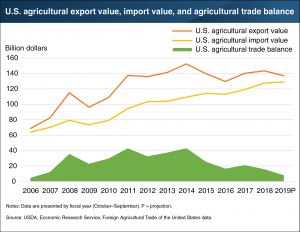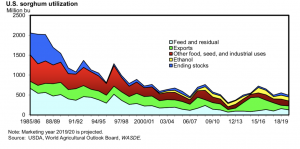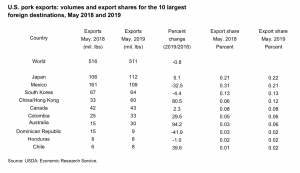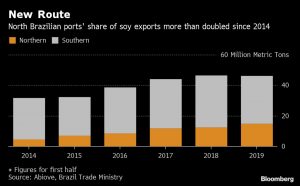China Plans Purchase of U.S. Farm Products, According to Reports
Since U.S., China trade negotiations resumed late last month, conflicting perspectives have emerged with respect to China’s promise to purchase large amounts of U.S. farm products. Today’s update highlights recent news reports that discuss developments in U.S., China trade talks, as well as the issue of Chinese agricultural purchases.
Background- Trade Negotiations Continue, Chinese Sorghum Purchases
Early last week, Bloomberg writer Josh Wingrove reported that, “Treasury Secretary Steven Mnuchin said he and U.S. Trade Representative Robert Lighthizer may travel to Beijing for trade negotiations if talks by phone this week are productive.
“‘We expect to have another principal-level call this week, and to the extent we make significant progress, I think there’s a good chance we’ll go there later,’ Mnuchin said Monday at a briefing for reporters at the White House.”
On Tuesday, Bloomberg’s Justin Sink reported that, “President Donald Trump reiterated that he could impose additional tariffs on Chinese imports if he wants, after promising to hold off on more duties in a trade-war truce he reached with China’s Xi Jinping last month.
“‘We have a long way to go as far as tariffs where China is concerned, if we want. We have another $325 billion we can put a tariff on, if we want,’ Trump said. ‘So, we’re talking to China about a deal, but I wish they didn’t break the deal that we had.’
“China said Wednesday that further levies would complicate the negotiations.”
“U.S. agricultural exports are projected to total $137.0 billion in fiscal year (FY) 2019 (October 2018–September 2019), while agricultural imports are expected to total $129.0 billion, according to ERS’s latest Outlook for U.S. Agricultural trade. The $8.0 billion surplus projected for FY 2019 is the lowest since FY 2006, when the U.S. exported $4.6 billion more in agricultural goods than it imported.” (“U.S. agricultural trade balance is projected to fall to $8.0 billion in fiscal 2019,” USDA- Economic Research Service. Chart of the day, June 19, 2019, https://bit.ly/2IsLgY1).
Later last week, Reuters News reported that, “U.S. and Chinese officials spoke by telephone on Thursday as the world’s two largest economies seek to end a year-long trade war, with U.S. Treasury Secretary Steven Mnuchin suggesting in-person talks could follow.
‘Right now we’re having principal-level calls and to the extent that it makes sense for us to set up in-person meetings, I would anticipate that we would be doing that,’ Mnuchin told Reuters.
The Reuters article noted that, “Asked if Thursday’s call could lead to a face-to-face meeting, Mnuchin said: ‘It’s possible, but I’m not going to speculate on the outcome.’
“Lighthizer’s office later confirmed that the conversation took place as scheduled, but gave no details.
“China’s foreign ministry said on Friday the two sides had discussed ways to implement the consensus reached by the two countries’ presidents, but gave no other details.”
Meanwhile, Reuters writer Tom Polansek reported last week that, “China made its biggest purchase of U.S. sorghum since April last week, according to U.S. Department of Agriculture data issued on Thursday, as Washington and Beijing revive discussions to end their trade war.
“The world’s top sorghum importer bought 51,072 metric tons of the grain even though China imposed a 25% tariff on American shipments in July 2018 as part of the tit-for-tat trade dispute. The purchases will likely be used to feed livestock or make a fiery Chinese liquor called baijiu.
“China has made other modest purchases of sorghum since the beginning of June.”
Capehart, Tom, Liefert, Olga, Olson, David W., Feed Outlook, FDS-19g, U.S. Department of Agriculture, Economic Research Service, July 15, 2019.
Mr. Polansek noted that, “The United States and China agreed last month to restart trade talks that stalled in May. U.S. President Donald Trump said at the time he would not to impose new tariffs and U.S. officials said China agreed to make agricultural purchases. But Trump said on July 11 that China was not living up to promises to buy U.S. farm goods.
“U.S. farmers welcomed the latest sorghum sale as the crop was one of the first casualties of the trade war, which has also slowed exports of U.S. soybeans and pork to China.”
News Reports: China Plans U.S. Farm Purchases
On Sunday, Bloomberg writer Dominic Lau reported that, “China’s importers have started making arrangements to buy U.S. agricultural products, Global Times’s Editor-in-Chief Hu Xijin said in a tweet, without specifying where he got the information.
“The possible purchase of American farm products — which adds to recent gestures of goodwill between both sides — also indicates U.S.-China trade talks will restart soon, according to the tweet.”

Hu Xijin 胡锡进
✔@HuXijin_GT
Based on what I know, Chinese importers have started arrangement of purchasing US agricultural products.This is a prominent part from Chinese side as the two countries have signaled goodwill to each other recently. It also indicates China-US trade consultations will restart soon.
The Bloomberg article added that, “Senior U.S. and Chinese officials spoke by phone last week, the second call since a late June summit where the two sides agreed to a truce in their ongoing trade spat.”
And Reuters writer Michael Martina reported on Sunday that, “Some Chinese companies are seeking new purchases of U.S. agricultural products, China’s official Xinhua news agency said on Sunday, citing authorities, as Beijing and Washington look for ways to end a protracted trade war.”
The Reuters article stated that, “Chinese businesses have made inquiries with U.S. exporters to buy crops and agricultural products and applied for the lifting of tariffs, Xinhua said, citing Chinese authorities.
“China’s Customs Tariff Commission will arrange for experts to appraise the Chinese companies’ tariff exclusion applications, Xinhua said.
“‘Relevant Chinese departments expressed hope that the United States would meet China halfway, and earnestly implement the United States’ relevant promises,’ the news agency said, without elaborating.”
Trade Wars’ Impacts Persist
Bloomberg writer Mike Dorning reported last week that,
U.S. pork producers are losing $1 billion annually because of the Trump administration’s trade war with China, said David Herring, an industry association official.
“Herring, president of the National Pork Producers Council, told a House Agriculture subcommittee on Tuesday that retaliatory tariffs imposed by China and other countries are ‘one of the most damaging threats‘ to his industry. The dispute with the Asian nation has cost producers $8 per animal annually.”
“U.S. pork exports were 511 million pounds in May, almost 1 percent lower than shipments in May of 2018.”(Livestock, Dairy, and Poultry Outlook, LDP-M-301, U.S. Department of Agriculture, Economic Research Service, July 17, 2019).
Also last week, Bloomberg writer Isis Almeida reported that, “President Donald Trump’s trade war will change forever the way top importer China buys its soybeans.
“ADM Sees Tariff War Changing China’s Soy Trade Pattern for Good,” by Isis Almeida. Bloomberg News (July 17, 2019).
“That’s according to Archer-Daniels-Midland Co., one of the world’s largest agricultural commodities trader.
The tit-for-tat tariff spat, which has already shrunk purchases of American beans, probably will mean China will try to reduce its dependence on the U.S. by buying from elsewhere and improving yields of its own production, ADM Chief Financial Officer Ray Young said.
“‘We should not be naive to assume that longer term, China will not want to become more self-reliant on their own supply of agriculture products,’ he said at the Kansas Fed Ag Symposium Tuesday. ‘I think this has been a wake-up call for China in terms of understanding the relationship between the U.S. and China and how they will view food security in the future.’”
Source: Keith Good, Farm Policy News





